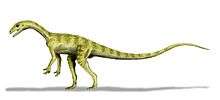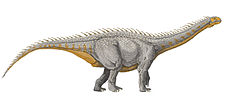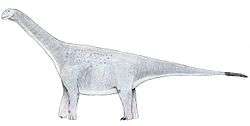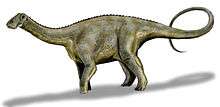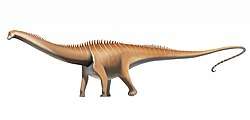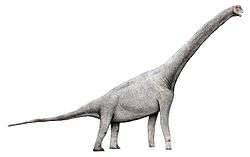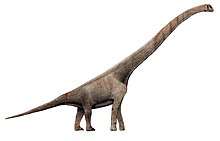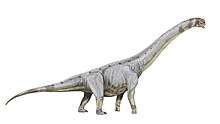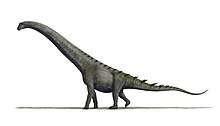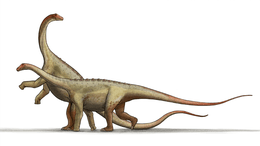Tazoudasaurus
Tazoudasaurus is a genus of vulcanodontid sauropod dinosaurs hailing from the Early Jurassic, located in the High Atlas Mountains of Morocco in North Africa. Along with Ohmdenosaurus is one of the two formally described sauropods from the Toarcian of the northern hemisphere.
| Tazoudasaurus | |
|---|---|
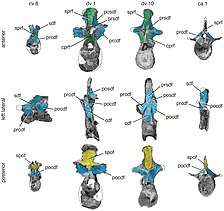 | |
| Representative vertebrae of Tazoudasaurus naimi | |
| Scientific classification | |
| Kingdom: | Animalia |
| Phylum: | Chordata |
| Clade: | Dinosauria |
| Clade: | Saurischia |
| Suborder: | †Sauropodomorpha |
| Clade: | †Sauropoda |
| Clade: | †Gravisauria |
| Family: | †Vulcanodontidae |
| Genus: | †Tazoudasaurus |
| Species: | †T. naimi |
| Binomial name | |
| †Tazoudasaurus naimi Allain et al., 2004 | |
Discovery
The remains, consisting of a partial adult skeleton and associated partial juvenile skeleton found in continental detrital sediments of the Toarcian aged Azilal Formation, were described by Ronan Allain et al. in early 2004. The generic name derives from one of the localities, Tazouda, while the specific descriptor is a latinization of the Arabic term for "slender" due to the animal's small size for a sauropod.[1] Its fossil was found alongside that of Berberosaurus and an indeterminate Large Theropod.[2]
Description
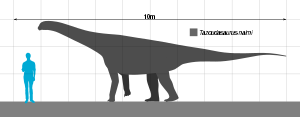
Tazoudasaurus, a small sauropod at 11 meters (36 feet) long, is characterized by rather primitive features such as the prosauropod-like mandible with spatulate and denticle-bearing teeth, lack of a U-shaped mandibular symphysis as other more derived sauropods. Teeth wear in V-shaped marks indicates tooth occlusion, suggesting that vulcanodontids processed food orally when feeding. The frontal and the parietal are incomplete, the former being broken anteriorly and the latter posteriorly. The neck is flexible with elongate vertebrae that lack true pleurocoels while dorsal and caudal vertebrae series tend to be more rigid. T. naimi bears the most complete fossil skeleton for Early Jurassic sauropod remains found to date due to the scarcity of exposed strata of that age.[3]
Classification
This sauropod is most closely related to Vulcanodon, differing only in caudal vertebrae features while it also possesses characters that place it outside Eusauropoda.[4]
See also
References
- Allain, Ronan; Najat Aquesbi; Jean Dejax; Christian Meyer; Michel Monbaron; Christian Montenat; Philippe Richir; Mohammed Rochdy; Dale Russell; Philippe Taquet (2004). "A basal sauropod dinosaur from the Early Jurassic of Morocco" (PDF). Comptes Rendus Palevol. 3 (3): 199–208. doi:10.1016/j.crpv.2004.03.001. ISSN 1631-0683.
- Allain, R., Tykoski, R., Aquesbi, N., Jalil, N. E., Monbaron, M., Russell, D., & Taquet, P. (2007). An abelisauroid (Dinosauria: Theropoda) from the Early Jurassic of the High Atlas Mountains, Morocco, and the radiation of ceratosaurs. Journal of Vertebrate Paleontology, 27(3), 610-624.
- Peyer, K., & Allain, R. (2010). A reconstruction of Tazoudasaurus naimi (Dinosauria, Sauropoda) from the late Early Jurassic of Morocco. Historical Biology, 22(1-3), 134-141.
- Allain, Ronan; Aquesbi, Najat (2008). "Anatomy and phylogenetic relationships of Tazoudasaurus naimi (Dinosauria, Sauropoda) from the late Early Jurassic of Morocco" (PDF). Geodiversitas. 30 (2): 345–424.
